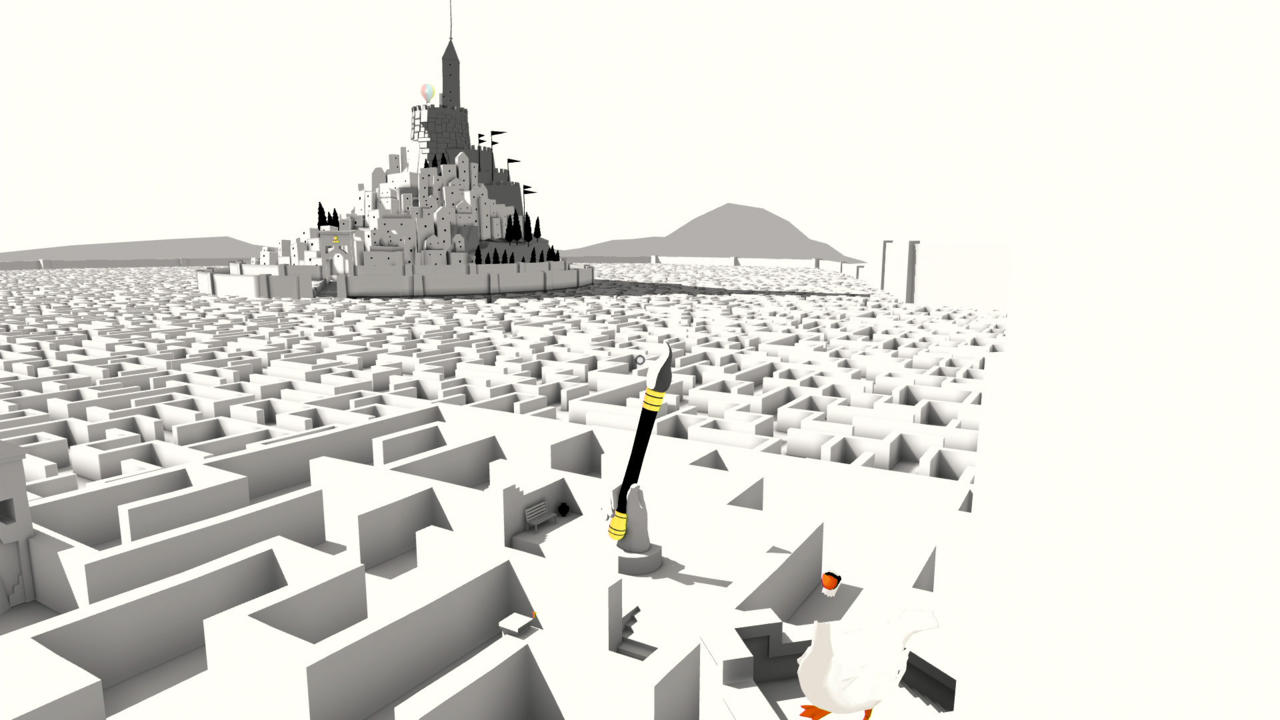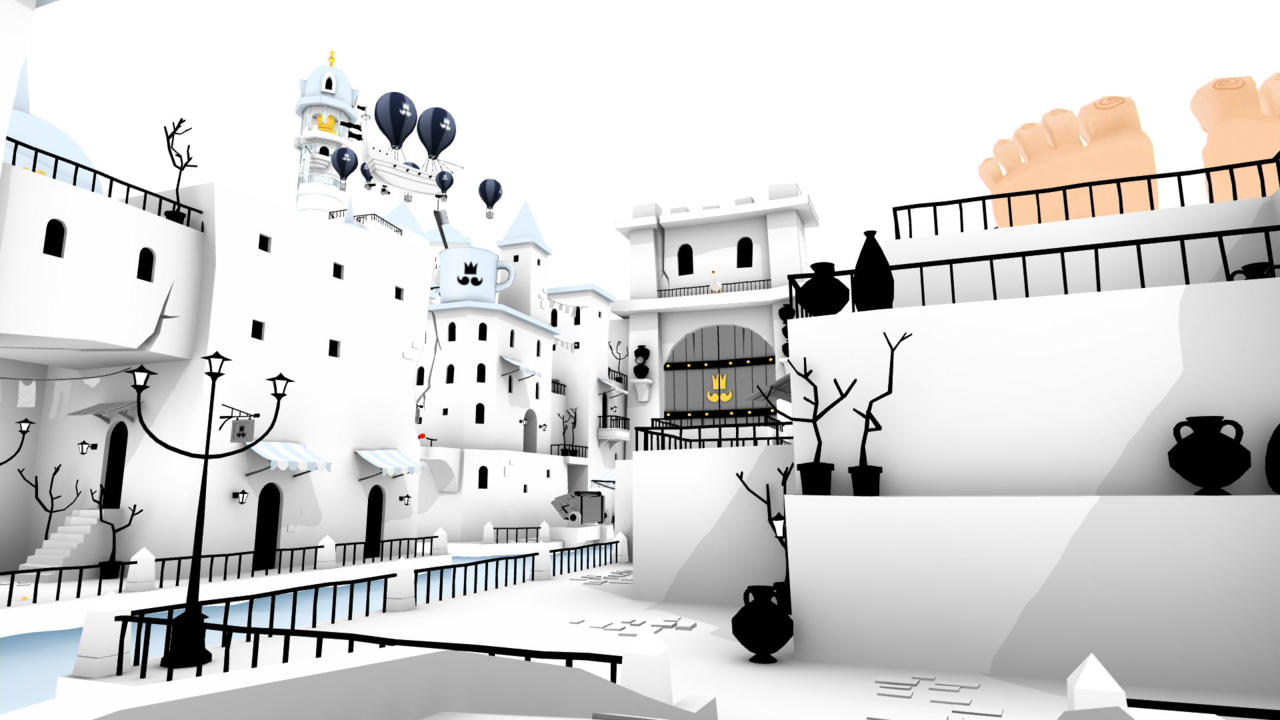The Unfinished Swan starts with a kind, grandmotherly voice telling the story of Monroe, a newly orphaned young man, whose mother has just passed away, leaving him orphaned, leaving him nothing but her last, unfinished painting of a swan. Soon after, the disembodied bird flaps off into the blank white nothingness of the painting, and Monroe follows. The storybook narration ends, the screen fades to white, and you're left with one of the most exhilarating moments in all of gaming.
You're left with nothing.
The screen fades to completely empty white space, with a tiny circle reticule in the center. You hit one of the triggers or the touchpad, and Monroe throws an ink pellet, making his first haphazard black splotch on the world, and highlighting the way forward.

What follows is a first person game unlike anything else: An abstract, Jackson Pollock work of art of the player's making, where objects only take shape after you've splashed black paint all over the canvas, giving shape to each object, making the objects and paths stand out by contrast with the paint alone. The world of The Unfinished Swan, in this first chapter, is a world of blank castles, paths, park benches, shallow ponds, blank statues, and rusty, creaking gates, all of which exist, and yet don't exist, until Monroe makes his mark. It's an elegant, soothing aesthetic, giving the player all sorts of leeway to play and make things messy, while still creating something pleasing to the eye. After traversing the landscape awhile, you reach higher ground and are able to look back over your creation. This sight might be one of the most transcendent, fascinating moments in any game, seeing black and white spatters form shapes, animals, architecture, and natural beauty. That unexpected beauty, unfortunately, only makes the fact that the game starts filling in the blank space with color and shadow in the next three chapters all the more disappointing.
This was the issue with The Unfinished Swan in 2012, and it's not an issue that the pretty 60 frames-per-second, 1080p upgrade could ever fix. Yet, knowing what the PS4 is capable of, it's still a bit of a crestfall. That's not to say that what comes after the first chapter is bad, per se. On the contrary, taken as a separate, simple tale of a boy exploring the vast sterile wonderland of his parents' imaginations, it's still a playful exercise in curiosity and exploration. It's one of the most thoughtful and endearing uses of the first person perspective in quite some time, bolstered by a quirky, gentle electronic ambient score, and a soft, melancholy subtext of divorce and the death of loved ones.

The storybook narration ends, the screen fades to white, and you're left with one of the most exhilarating moments in all of gaming.
Because the game is so very short--about two or three hours long--no one stage lasts long enough to wear out its conceptual welcome. The game ushers you in pursuit of the titular swan, through vast, Draconian labyrinths, wide, open, Mediterranean plazas, hot air balloon platforms, twisting vines that grow and stretch in whatever direction you toss water balloons, and spooky adventures in shadowed forests, lit by the light of strange luminescent fruit. Embedded in that stage is the one section in which the game comes close to the first chapter's brilliance: a section in which Monroe jumps into a painting, and finds himself in a Cubist rendition of the current area, where he can use his ink/water pellets to create geometric shapes and platforms. It's there and gone as fast as it came, but it's still a joyous change of pace at a point in the game where it's most needed. And in between, the story is still told, through new pages of the story revealed by splashing ink on golden letters, telling fun, simple tales of the king who once ruled the empty lands, and his troubles. And yet, even then, where the game goes is not nearly as powerful a statement on artistry and imagination as where it starts. What was once snowblind exploration turns into simple problems and puzzles of physics.

While the game that follows is a satisfyingly twee Golden Book of a game, the first chapter lets the player's imagination do the heavy lifting in a way games never do. The ink only provides a rudimentary outline for your world, and any sense of the overarching land comes entirely from within. It's euphoric, that power. It stretches muscles that games don't allow unless you're playing a text adventure. Once the game starts filling in the blanks for you, giving the buildings shadows and color and concrete shapes, those muscles are laid to rest for the rest of the game. No matter how much the game's inherent playfulness and imagination is being flirted with, no matter how pleasant the narration is, especially when Terry Gilliam--yes, that Terry Gilliam--shows up for a late game cameo, the fact is that what was once abstract, existing predominantly in the player's mind, is now being made solid by someone else.
That fact strips it of a groundbreaking ambition that the gaming world needs so much more of. The Unfinished Swan presented in Chapter One could've sustained a few hours by itself. Instead, it takes up only half an hour, followed by another few hours that settle for being simply great and delightful. It's the kind of failure many developers work their fingers to the bone to achieve.